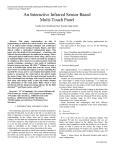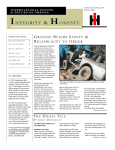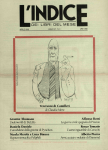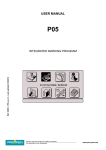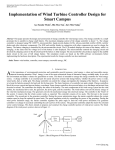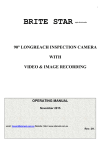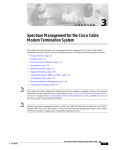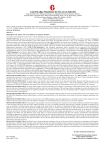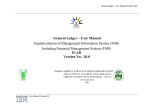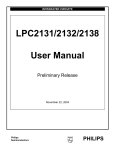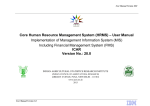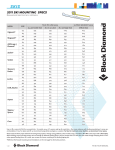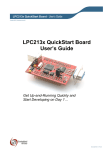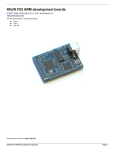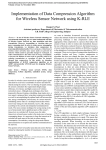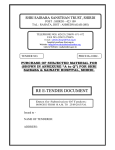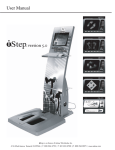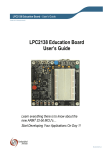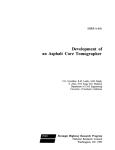Download view full paper - International Journal of Scientific and Research
Transcript
International Journal of Scientific and Research Publications, Volume 5, Issue 1, January 2015 ISSN 2250-3153 1 Advanced shoes with embedded position tracking and path guidance to keep track of Alzheimer’s patients Miss. Smita S. Auti*, Prof. Nagnath B. Hulle** * Electronics & Telecommunication Dept., GHRCOEM, Chas, Ahmednagar, India ** Electronics & Telecommunication, GHRIET, Wagholi, Pune, India Abstract- The system is a flourishing research area in the field of wireless communications. This paper presents the overall framework of the necessity as a safety monitor for Alzheimer’s patients. Alzheimer’s patient is a person having the difficulties about memory with the concepts of place & time. Global Positioning System (GPS) locator watches for patients are essentially RT-trackers that allow the family members or caregivers to have a complete access to whereabouts of person 24hrs. The GPS technology is placed inside a cavity made from a polycarbonate material which is in the midsole of the shoe. GTX says, the normal duration of the shoe - one to three years. The design of the system gives Energy efficiency, robustness, and reliability. Patient is having a mobile sensor unit which includes a GPS chip and antennas. Mobile sends latitude, longitude, and a time stamp. A GTX tracking map gives the latitude and longitude information on a geographical information system (GIS). The developed system can be used to track a specific area of patients. The main advantage of the system is a multilingual system. This means that we store the wav file in any language and play it back. Index Terms- Alzheimer’s patients, GPS, GTX tracking map, UID, RT- trackers. I. INTRODUCTION A s millions of baby boomers approach towards the age of 65, the rates of Alzheimer’s sufferers are expected to continue to rise significantly in the coming decade. About 5.4 million Americans are living with the disease that figure predicted to rise to as many as 16 million by 2050, according to the Alzheimer's Association. To make easier for caregivers and family members to keep track of those suffering dementia, Personal Location Services Company GTX Corp has partnered with comfort shoe manufacturer Aetrex to produce the GPS Shoe that allows real-time tracking of the wearer. [1] GTX started out producing footwear for children with a miniaturized GPS chip and cellular device embedded in the sole that allowed parents to keep track of their offspring via an online portal and then started offering similar shoes aimed at long distance runners. The technology is also beneficial in keeping track of those suffering dementia to embed its GPS technology into comfort and wellness shoes for the elderly. There are already a number of wearable GPS devices such as watches and bracelets designed to keep track of loved ones he or she will be young and old. Shoes are a perfect fit for the technology as it's something the person being track is unlikely to wander off without. It is more relax or the elderly than the GPS platform shoes we looked at a few years ago. The GTX system uses low power two-way GPS tracking technology. It continually tracks the location and movement times spent by of the wearer and relays the information to a monitoring center through mobile networks. The wearer is pinpointed by logging into a secure internet portal or via smart phone applications. The system also allows caregivers to receive an alert message or alarm on their smart phone or computer. There is a direct link to Google maps plotting the wearer's location when the GPS shoe moves outside a preset area. [1] II. SYSTEM DESIGN The system proposed the GPS based wireless Shoes with path guidance. For this first store the co-ordinates coming from the GPS and the name of the place in to the SD card via the matrix Keyboard. Also store the voice from the user which records the name and other information about the place which can guide the patient or the person wearing the shoes. After this as soon as the user wears the shoes, the µc continuously compares the latitude and the longitude co-ordinates coming from the GPS every second with the co-ordinates stored in the SD card memory. If at any place the coordinates match then for that particular place the proposed system informs to user loaded information. The system shoes the name and other details of that place on the LCD and also can hear the info about the place from the earpiece. Also mobile sends these coordinates to the base unit via the GSM modem .The PC receives these coordinates via GSM and redirects these latitude and longitude coordinates to the visual basic software. The VB s/w then shows these coordinates on the GOOGLE map so that the person can exactly locate the location of the user. The wireless helmet is a very well-organized tool for path guidance and also for tracking the user wearing the helmet via GOOGLE maps. The major factors considered in the system design are energy efficiency and reliability. The mobiles are battery powered and therefore need energy-efficient hardware and software. This can achieve by optimizing the data volume and signal processing to minimize energy consumption. One technique is to minimize the duty cycle (percentage of time the mobile node www.ijsrp.org International Journal of Scientific and Research Publications, Volume 5, Issue 1, January 2015 ISSN 2250-3153 is on) using sleep/awake protocol. The fixed units, on the other hand, do not necessarily have strict restrictions on energy and processing power. For example, draw energy from the power supply of the street lighting system. Nevertheless, their communication range is limited in a similar way to the mobile units due to regulations on emission and coexistence issues with other wireless networks in the area. [2] RF ID based bank application Here As soon as the Alzheimer patient goes to a bank then the Bank RFID receiver picks up the RFID tag and displays all 2 the information to the Alzheimer patient required by his to do his normal banking transaction. GSM based appointment scheduler: The Alzheimer patient will be reminded about his appointments and meetings via SMS. This SMS is sent by the home server based VB s/w. On PC we have VB s/w which will have all the details of the appointment and meeting of the Alzheimer patient. As soon as the present time matches with the set time in VB the VB s/w will send an SMS to the Alzheimer patient reminding him about his appointments and meetings THE VISUAL BASIC SOFTWARE FOR BANKING SOFTWARE BLOCK DIAGRAM www.ijsrp.org International Journal of Scientific and Research Publications, Volume 5, Issue 1, January 2015 ISSN 2250-3153 3 trace support, that combine the microcontroller with 32KB, 64KB, 128KB, 256KB and 512KB of embedded high-speed flash memory [8]. Due to their tiny size and low power utilization, these microcontrollers are ideal for applications where miniaturization is a key requirement, such as access control and point-of-sale. With a wide range of serial communications interface and onchip SRAM options of 8KB, 16KB, 32KB, they are very well suited for communication gateways and protocol converters, soft modems, voice recognition and low-end imaging, providing both large buffer size and high processing power. Various 32-bit timers, single or dual 10-bit 8-channel ADC(s), 10-bit DAC, PWM channels are present. The 47 GPIO lines with up to nine edge or level sensitive external interrupt pins make these microcontrollers particularly suitable for industrial control and medical systems and also many more.[8] III. BLOCK DIAGRAM DESCRIPTION ARM LPC 2138: The microcontroller (µc) unit receives these coordinates and compares it with the co-ordinates stored in serial memory. If both match, the corresponding advertisement is displayed on the LCD. The µc reads the coordinates received via GPS. The µc is interfaced to a µSD card (up to 2 GB). For this install the fat file system (16 bit) on the SD card. Then store all the word files in the SD card in *.wav format in a database. As soon as the GPS co-ordinates are received the µc will compare the co-ordinates with the heading of all the wav files stored. For example if we store the wav file for co-ordinates “1234.5678 “ then the corresponding name of the sound file will be “12345678.wav”. So the µc will compare received coordinates will search for the wav sound file having the name going and will play back the sound file. In this manner create the database of 4000-5000 wav files to create our own voice library. The main advantage of the system is a multilingual system. This means that we store the wav file in any language and play it back. The only thing is that the user has to enter the same name of the file. The matrix kb is used to store the GPS coordinates as well as the name of place in the serial memory. The I2C bus based serial EEPROM is used to store these co-ordinates in memory. Features of microcontroller :A 128-bit wide memory interface and unique accelerator architecture enable 32-bit code execution or implementation at maximum clock rate. The LPC2132/34/36/38 microcontrollers are based on a 16/32-bit ARM7TDMI-S CPU with real-time emulation and embedded LIQUID CRYSTAL DISPLAY: The received co-ordinates are shown on the graphical LCD. Also the name of place that matches with the database is displayed on LCD. LCD is used in a project to visualize the output of the application. We have used 16x2 LCD which indicates 16 columns and 2 rows. So, we can write 16 characters in each line. So, total 32 characters we can display on 16x2 LCD. LCD can also used in a project to check the output of different modules interfaced with the microcontroller. Thus LCD plays a vital role in a project to see the output and to debug the system module wise in case of system failure in order to rectify the problem. Keypad MATRIX: The keypad is in standard format of eight pin connector. The 4x4 keypad has the layout like the table shown below. BK is backspace while entering the password. EN is enter and is used do enable/disable menu item or enable the system. Keyboards are the most widely used input device of the 8051, and the basic understanding of them is important. At the lowest level, keyboards are arranged in matrix form of rows and columns. The CPU accesses both rows and columns through ports: therefore, with two 8-bit ports, an 8 X 8 matrix of keys can be connected to microcontroller. When a key is pressed, a row and a column make a contact: otherwise, there is no connection between them. www.ijsrp.org International Journal of Scientific and Research Publications, Volume 5, Issue 1, January 2015 ISSN 2250-3153 4 GSM is a digital mobile telephony system. With the help of GSM module interfaced, we send short text messages to the required authorities as per the request. GSM module is provided by sim uses the mobile service provider and send message to the respective authorities as per programmed. This technology enables the system a wireless system with no specified range limits. GSM uses a variation of time division multiple access (TDMA) and is the most widely used of the three digital wireless telephony technologies such as TDMA, GSM, and CDMA. GSM digitizes and compress data, then sends it down a channel with two other streams of user data, each in its own time slot. It operates at 900 MHz to 1800 MHz frequency band. IV. SCANNING AND IDENTIFYING THE KEY The rows are connected to an output port and the columns are connected to an input port. If no key has been pressed, reading the input port will yield 1s for all columns since they are all connected to high (VCC). If all the rows are grounded and a key is pressed, one of the columns will have 0 since the key pressed provide a path to ground. It is function of the microcontroller to scan the keyboard constantly detect and identify the key pressed. To detect pressed key, the microcontroller grounds all rows by providing 0 to the output latch, then it reads the column. If the data read from the columns D3 to D0 =1111, no key has been pressed and the process continues until a key press is detected. However, if one of the column bits has a 0, this means that a key press has occurred. For example If D3 to D0 = 1101, this means that a key in the D1 column has been pressed. After a key press is detected, the microcontroller will go through a process of identifying the key, starting with the top row, the microcontroller grounds it by providing a low to D0 only: then it reads the columns. The data read is all 1s, no key in that row is activated and the process is moved to the next row. It grounds the next row, reads the columns, and checks for any 0. This process continues until row is identified. After the identification of the row in which the key has been pressed, the next task is to find out which column the pressed key belongs to. GPS MODEM: The GPS smart receiver features the 16 channels .Ultra low power GPS architecture. This complete enabled GPS receiver provides high position, velocity and time accuracy performance as well as high sensitivity and tracking capabilities. Benefits1. Ultra low power utilization 2. Easy and fast to install 3. Superior urban canyon performance 4. Low cost with high performance SD CARD: SD card is basically is used as a storage device which will required to store the required data. The system database can be used to store in SD card in the form of .wav file and can be accessed from that whenever it is required. SD card is interfaced with the system using a protocol called SPI protocol. [1] The GPS Shoes allow real-time tracking of the wearer [1] ACKNOWLEDGMENT RS 232: RS 232 IC is a driver IC to convert the µC TTL logic (0-5) to the RS 232 logic (+-9v). Many device today work on RS 232 logic such as PC, GSM modem , GPS etc. so in order to be in touch with such devices we have to bring the logic levels to the 232 logic (+/-9v). GSM MODEM: I am glad to introduce my seminar on “Advanced shoes with embedded position tracking and path guidance to keep track of Alzheimer’s patients” in the vast field of electronics. With respect and deep gratitude I wish to express my sincere acknowledgment to Dr. Vinod Chowdhary for giving me good opportunity to give seminar. I express sincere thanks to my seminar guide Prof. Nagnath Hulle for his/her kind co-operation and valuable guidance that render to me each stage for my seminar. www.ijsrp.org International Journal of Scientific and Research Publications, Volume 5, Issue 1, January 2015 ISSN 2250-3153 I am highly grateful to my ME Coordinator Prof. V.P. Bhope for extending all facilities in completing this seminar and also all staff members of Electronics & Telecommunication Department who directly or indirectly have helped me for completion of my seminar. Last but not the least I thanks my beloved parents for their immortal and financial support and I dedicated this project to my parents. V. CONCLUSION Proposed implementation presents the overall framework of the necessity of positioning system as a safety monitor for Alzheimer’s patients. It is easy to find and guide the Alzheimer’s patient by sitting on one place. We can apply the system for the child also for safety and perfect guidance. The design provides an option (such as an alarm button on the mobile unit) for patient to request help in case of emergency. The location information is mapped onto a GIS system for ease of localization and efficiency in providing help. Our experiments show that the system is robust and trustworthy. In this view, location recognition is an application field, but the idea may be applied to other scenarios. REFERENCES [1] Darren Quick (October 26, 2011), Comfort shoes with embedded GPS to keep track of Alzheimer's patients available at: www.google.com [2] [3] [4] [5] [6] [7] [8] 5 M. Mohandes, “Wireless Sensor Networks for Pilgrims Tracking,” IEEE embedded systems letters, vol. 4, no. 4, December 2012 P. Zhang, C. M. Sadler, S. A. Lyon, and M. Martonosi, “Hardware design experiences in zebra net,” in Proc. 2nd Int. Conf. Embed. Network Sensor Syst., New York, 2004, pp. 227–238, ACM Press. M. Mohandes, “RFID-based system for pilgrims identification & tracking,” J. Appl. Compute. Electromagnet. Soc. (ACES), vol. 25, no. 3, pp. 273– 282, Mar. 2010. Igor Bisio, “GPS/HPS-and Wi-Fi Fingerprint-Based Location Recognition for Check-In Applications Over Smart phones in Cloud-Based LBSs” ieee transactions on multimedia, vol. 15, no. 4, June 2013 Andrea Sciarrone, Context and Location Awareness, Indoor Localization, Security and e-health Applications, Android Operative System. Mohandes, Haleem, Abul-Hussain, and Balakrishnan, “Pilgrim tracking using wireless sensor network,” presented at the Workshops Int. Conf. Adv. Inform. Netw. Appl. (WAINA 2011), Singapore, Mar.22–25, 2011. LPC2131/2132/2138 User Manual File Format: PDF/Adobe Acrobat November 22, 2004. Philips Semiconductors. Preliminary User Manual. LPC2131/2132/2138. ARM-based Microcontroller... (LPC2138 with 512kB Flash). www.mct.de/download/philips/lpc213x.pdf AUTHORS First Author – Miss. Smita S. Auti, Electronics & Telecommunication Dept., GHRCOEM, Chas, Ahmednagar, India, [email protected] Second Author – Prof. Nagnath B. Hulle, Electronics & Telecommunication, GHRIET, Wagholi, Pune, India, [email protected] www.ijsrp.org





